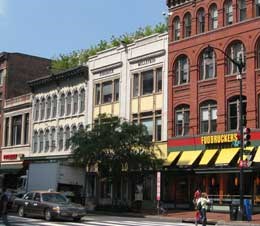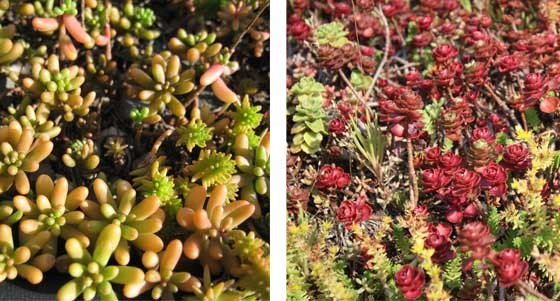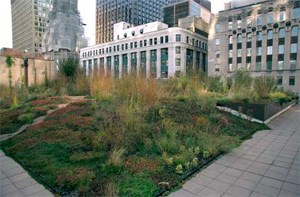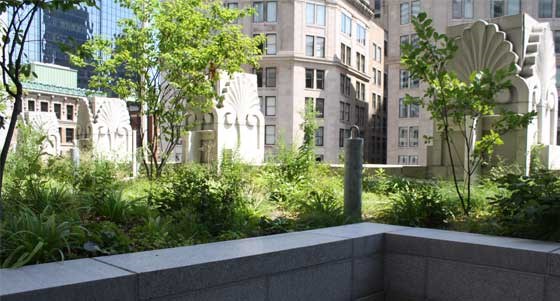Last updated: March 31, 2022
Article
Green Roofs on Historic Buildings: Plants for Green Roofs

Along with the makeup and depth of the growing medium, selecting the right plants is crucial to the success of a green roof. The plants chosen must be appropriate for the roof type—extensive, intensive, or semi-intensive. Climate clearly plays a major role in choosing the best plants for a green roof. It is also important to be aware that a separate microclimate with strong winds and extreme temperatures can sometimes exist at roof level of high rise buildings. If using native species, indigenous plants should be selected that have worked well on green roofs and ensure they are watered and maintained according to their specific needs. It is always best to choose hardy, low–maintenance plants that can survive mainly on rainwater and require no special irrigation or nutritional needs rather than high–maintenance specimens.
Soil depth and whether the roof will have initial or continued irrigation will also need to be factored in. Equally important in plant selection is the purpose of the green roof and the reason for installing it, whether it is storm water management, energy conservation, heat island reduction, aesthetics, or a combination of these factors. A landscape architect or accredited Green Roof Professional should also be involved in plant selection and the roof design, especially if the roof is to be open to the public. If the roof is to be used year round, consideration should be given to balancing plants that bloom, that are green all year, or that turn brown during the winter. All of these factors, including initial and continuing maintenance costs must guide plant selection.

The size and expected height of vegetation when mature should also be taken into account. Some plants that are low to the ground when first installed on a green roof may grow to be quite tall over time and, thus, visible from public view. Vegetation growing above the roofline may negatively impact the historic character of the building. Therefore, it is important to choose plants that will not substantially increase in height when planning a green roof on a historic building.
Regardless of the plants selected, a green roof still requires maintenance that a traditional roof does not. Weeds and other plant seeds are likely to be deposited on the roof by birds, insects, and the wind. Thus, the roof should be weeded periodically to remove invasive species and to prolong the life of the plants and growing medium. While most green roofs do not need irrigation systems, a temporary irrigation system or watering plan should be in place to nurture the plants until they are established or when there is a drought. Although no green roof is completely maintenance free, with regular attention it should last a long time.

Plants for Extensive Green Roofs
Plants for extensive green roofs should have low growth height, rapid growth/spreading, and fibrous roots that have high drought tolerance. Succulents, such as sedum, are often chosen for extensive green roofs because they withstand harsh conditions and minimize water loss. Succulents are one type of plant that utilizes crassulacean acid metabolism (CAM). Plants that utilize CAM open their stomata (pores used in photosynthesis) at night, taking up carbon dioxide, and keep their stomata closed during the day while they photosynthesize the carbon dioxide. Because of this characteristic, CAM plants minimize water loss, helping with stormwater management, while also offering the benefits of evapotranspiration (evaporating water from a plant by absorbing it through the roots and emitting it back out through the leaves as vapor–see also Green Roof Benefits). Non–CAM plants are more susceptible to heat and drought conditions and may therefor require irrigation. Grasses are often used, which offer a continuous meadow or field appearance, although they generally require more soil depth, additional watering, and maintenance.

Courtesy of the City of Chicago
Plants for Intensive and Semi–Intensive Green Roofs
An intensive green roof is more like a conventional garden or park and can have virtually no limit to the plant types that can be used. Due to the differences in growing medium between an extensive and intensive green roof, the latter can accommodate deeper plantings with more diversity. However, as stated earlier, it must be established that the building below can handle the extreme weight associated with an intensive roof. Not only is the growing medium deeper and therefore heavier, the plants themselves will grow larger, with larger root systems which must be accounted for.

Courtesy of GSA
In addition, growth rate and mature size of plantings on intensive green roofs must be evaluated for visibility and effects on the historic character of the building. Due to the added weight and greater maintenance needs, intensive green roof plantings will also be more expensive to install. Urban agriculture is growing in popularity providing opportunities to grow and harvest food from rooftops in cities. From herbs and salad greens to tomatoes and cucumbers, many individuals and restaurants are looking for opportunities to produce food locally.
